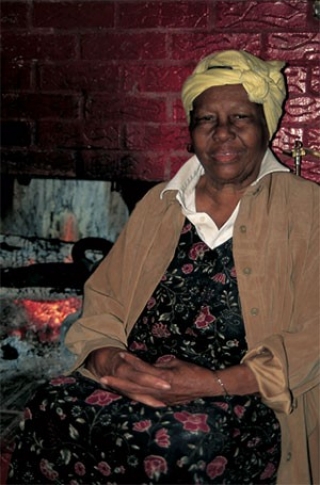Born 1928, Boykin (also “Gee’s Bend”), Alabama
Died 2013, Alberta, Alabama
Annie Mae Young made her first quilt while still a child, following knowledge traditionally handed down from mother to daughter in the region. It was a photograph of one of Young’s quilts around a half a century later that launched the quilters of Gee’s Bend to national fame. As part of the Freedom Quilting Bee, based in nearby Rehobeth, Alabama, which began exporting quilts in the 1960s, these quilters first found a receptive outside audience. But it was the traveling exhibition The Quilts of Gee’s Bend in 2002–2003 that made their name in the art world and beyond. The Whitney Museum of American Art displayed the quilts according to protocols usually reserved for painting, and the show made the front page of the New York Times, earning enthusiastic acclaim and comparisons to modernist abstraction. The singular aesthetic of the quilts, however, grew out of a vibrant collective practice framed by geographical isolation. Populated primarily by the descendants of enslaved Africans, the community sustained an uninterrupted, intergenerational quilt-making tradition.
Young had little patience with the delicate fabrics and techniques used by the Freedom Quilting Bee or the monotony of serial production. Instead, she gravitated toward tough, intractable materials such as denim, which she ripped up and combined in bold designs with gestural stitches. Working in an improvisational manner often compared to jazz, Young dynamically merged the conception and execution of her quilts. Gee’s Bend quilters frequently sang spirituals together and often shared their works through temporary yard displays, soliciting praise or criticism. Through this lively and intimate dialogue, quilters like Young forged recognizably individual styles.
On a strictly formal level, it is tempting to compare Blocks and Strips of 1970 to Hans Arp’s famous chance-based collage of torn squares from 1917; however, a rigorous structural logic underlies Young’s composition. As the title indicates, the quilt is built up from simple geometric swatches of fabric, pieced together into a rough grid. The irregular silhouette of the quilt as a whole reflects the crooked or varying shapes of its component pieces. The spaces between the dark rectangles flicker and pulse, interrupted by the strips of magenta and turquoise that snake through the white interstices. The undulating lines of stitching that bind the quilt top to its backing also imbue it with tactile and rhythmic energy.
Jenevive Nykolak
Beardsley, John, et al. Gee’s Bend: The Women and Their Quilts. Houston: Museum of Fine Arts, with Tinwood Books, Atlanta, 2002.
Cooks, Bridget R. Exhibiting Blackness: African Americans and the American Art Museum. Amherst: University of Massachusetts Press, 2011.
